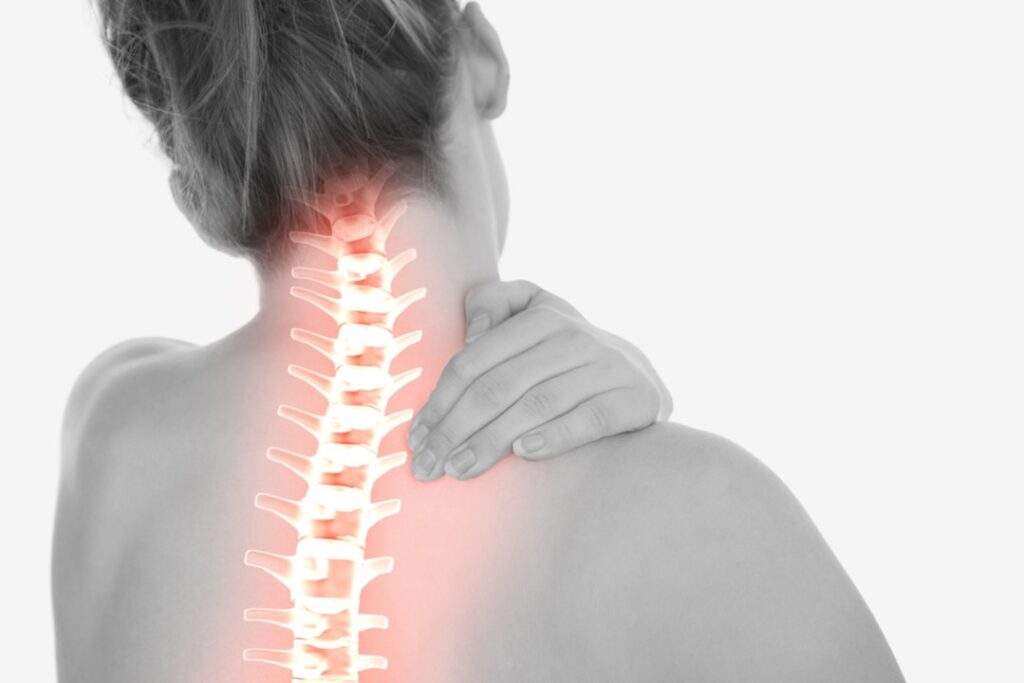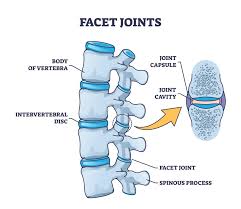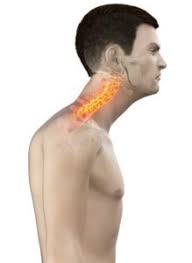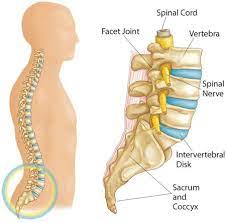

So how did my forward head posture damage my facet joints?
Well, this is an interesting story that I shall reveal when I progress with the article.
Nonetheless, after this, I did realize that a bad neck posture has far more damaging consequences on the body than what I already knew. I thought forward head posture damaged back muscles alone.
The facet joint damage was indeed an eye-opener for me.
Basically, a seemingly simple issue such as maintaining optimal neck and head posture is very important if you would like to enjoy a healthy, stress free and a painless lifestyle.
How did My Forward Head Posture Damage My Facet Joints: Article Index
1) What are Facet Joints?
2) What are the Main Functions of My Facet Joints?
3) What’s My Excuse behind My Bad Neck Posture?
4) How did My Forward Neck Lead to Facet Hypotrophy?
5) What are the Possible Complications caused by My Facet Joint Damage?
6) FAQs on Turtle Neck Posture & Facet Joint Stress
6) Takeaway
What are Facet Joints?
The apophseal joints (facet joints) get their name from their actions. Simply put, the facet joints are responsible for holding my vertebrae in position.
So, what is a vertebrae?
Well, a vertebrae is a bone that makes up your cervical spine. There are 7 cervical vertebras in total. As they are stacked one above the other, they need to be joined or else they shall fall apart.
This flexible joint is provided by none other than the facet joints.
These joints tend to connect the inferior articular process of one vertebrae with the superior articular process of the other. The motion segment of the spinal column comprises of two such facet joints.
So, what is a motion segment?
A motion segment comprises of one intervertebral disc and 2 vertebral bodies located adjacent to one another that are present within the vertebral column.
In my case, the C2 vertebrae was damaged the most, when compared to other vertebrae’s.
So, if we are now clear with what the facet joint is and what it is supposed to do for my cervical spine, let us more to the next step – the main functions of the apophseal joints.
What are the Main Functions of My Facet Joints?
@ The facet joints are vital for allowing me to place my head with pride right atop my neck.
@ As these are joining all the 7 cervical vertebras together, the apophseal joints are articulate in helping my neck maintain its natural posture.
@ The sideways movement of my neck is also a handiwork of the apophseal joints.
@ I can shift my head forward and backward without a fuss only because the apophseal joints are keeping my cervical vertebrae stacked one above the other.
@ If I shift my head in any direction in an excessive manner then, the risk of snapping it is high. This risk is covered by the strong yet flexible apophseal joints that STOPS my neck from shifting in any direction beyond its permitted capacity.
@ The apophseal joints contain cartilage that enable friction free movement between two vertebrae.
@ Laced with synovium, the facet joints enable me to shift my cervical spine in any angle without a fuss.
@ Apophseal joints also have a special lubricating fluid that tends to enable smooth movement of the cervical vertebrae.
@ The facet joints also permit a safe passage to the cervical nerves.
@ Finally, the facet joints enable optimal movement of the cervical, thoracic and lumbar region. This in turn implies flexing, rotation, extension etc.
What’s My Excuse behind My Bad Neck Posture?
I often question myself in front of the mirror whenever I am looking at my profile rather carefully.
When I see my head a few inches ahead of my shoulders, I know that my mirror is not lying.
So, what Caused my Nerd Neck?
No, it was not academics as I am not academically inclined in any which way. While I was not a nerd, I was not a dud either.
So, I did spend ample time studying for my examinations, I was not a book worm.
Basically, the reason for my explanation is to clarify that my nerd neck was not caused by excessive indulgence in academic pursuits.
So, what was it that caused me to develop a bad neck?
Well, it was a combination of unhealthy habits such as incorrect choice of reading books while lying on the bed and working for long hours on my laptop.
I believe the main culprit was my wrong choice of keyboards that caused my hunched posture.
I spent ample hours on my cell watching videos for hours. This action forced me to crane my neck in order to get a clearer glimpse of the miniscule screen.
The end result- in just 2 years, my head was more than 2 inches in front of its natural position. Besides giving me the aches and pains in the neck/upper back area, my forward neck also added 20 to 30 pounds of unwanted weight onto my cervical spine.
How did My Forward Neck Lead to Facet Hypotrophy?
Facet hypotrophy was something that I was not expecting. I was only considering minor stress to my upper back and shoulder muscles.
Nonetheless, on closer inspection by a medical professional, I was told that my laptop and cellphone addiction had indeed compressed my facet joints. The term he used was – facet hypotrophy.
Well, here are the some of the damages that took place:
@ the subchondral bone of the facet joints was compressed,
@ the fibrous capsule within my facet joints was also damaged,
@ the articular cartilage within the facet was also compressed,
@ finally, the synovium within the facet joints was also damaged partially.
Owing to the added weight being placed onto my cervical spine, the facet joints were compressed. So, the damage done affected my normal neck as well as head movement.
What are the Possible Complications caused by My Facet Joint Damage?
So, if I did not learn how to fix forward head posture fast, my facet joint injury could lead to several other complications.
Here are a few of these:
Osteoarthritis of the Facet Joint:
@ I could have suffered osteoarthritis owing to biomechanical loading of the cervical spine.
@ Arthritis is a leading cause for text neck and most people do not know this.
@ I could suffer from lesioning of the cartilage.
@ Hypertrophy is also a side effect of osteoarthritis.
@ Development of bone cysts of the synovial area is common.
@ Pain in the upper and middle back is normal.
@ In extreme cases, bone sclerosis is also possible.
Spinal Stenosis:
@ Owing to my forward head, added weight to the cervical spine may cause facet joint inflammation.
@ This inflammation may shrink the overall girth of my spinal canal.
@ My lower half of the body shall be in pain. My bad neck posture caused arch pain.
@ The neural elements shall be compressed and the possibility of neurological claudication is very high.
Degenerative Spondylitis:
@ There is a possibility of spur formation in my vertebrae.
@ The plate as well as the cartilage within the facet joint may face sclerosis.
@ The ligaments connecting to the facet joints may experience hypotrophy.
@ Facet joint is very likely to degenerate with time.
@ I would also experience pain in the entire back region.
Musculoskeletal Damage:
@ Forward head posture flexes the lower cervical vertebrae as well as the upper cervical vertebrae.
@ Your head is also forced to constantly shift forwards. This lead to degenerative disc disease.
@ The load bearing axis is now behind the head. Hence, the load onto your shoulder and neck muscles is phenomenal.
@ As per bestforwardheadposturefix.com, “Your craniovertebral extension muscles and noncontractile structures change your natural biomechanical movement”.
@ The end result is musculoskeletal damage. This gives rise to pain.
FAQs on Turtle Neck Posture & Facet Joint Stress
Forward head posture (FHP) is a common postural misalignment where the head is positioned forward of the body’s center of gravity. This misalignment can place undue stress on the cervical spine, particularly the facet joints, leading to various musculoskeletal issues. Here are five unique FAQs explaining how FHP can damage these joints:
Q1: How does forward head posture affect the alignment of cervical facet joints?
A1: FHP causes the head to shift forward, altering the natural curvature of the cervical spine. This misalignment increases compressive forces on the facet joints, leading to accelerated wear and potential degeneration.
Q2: Can forward head posture lead to facet joint inflammation?
A2: Yes, the increased pressure from FHP can cause inflammation in the facet joints. This inflammation may result in pain, stiffness, and reduced range of motion in the neck.
Q3: How does forward head posture contribute to facet joint degeneration?
A3: Sustained FHP places abnormal stress on the facet joints, disrupting the balance between joint loading and movement. Over time, this imbalance can lead to cartilage breakdown, bone spurs, and overall joint degeneration.
Q4: Are certain cervical levels more susceptible to facet joint damage due to forward head posture?
A4: Yes, the lower cervical levels, particularly C5 vertebrae to C7, are more vulnerable. FHP increases the load on these segments, making them more prone to facet joint issues.
Q5: Can correcting forward head posture alleviate facet joint discomfort?
A5: Yes, addressing FHP through exercises, ergonomic adjustments, and physical therapy can reduce the stress on facet joints, potentially alleviating discomfort and preventing further damage.
Maintaining proper posture is crucial for spinal health. If you experience neck pain or suspect facet joint issues, consult a healthcare professional for appropriate evaluation and management.
Takeaway
The overall importance of our facet joints cannot be undermined. When your vertebras are engaged with each other in a relative motion then, chances of damage owing to overload is very high.
Facet joints are the cushion that avoid damage during relative motion between vertebras. So, if my facet joints are damaged then, my cervical spine is susceptible to breakage.
I would never like that – would you???
Well, no one wants a damaged cervical spine just because you forgot to maintain optimal head and neck posture.
References:


